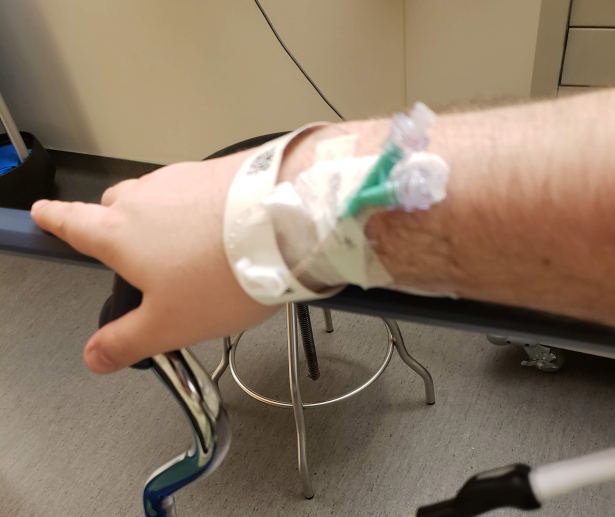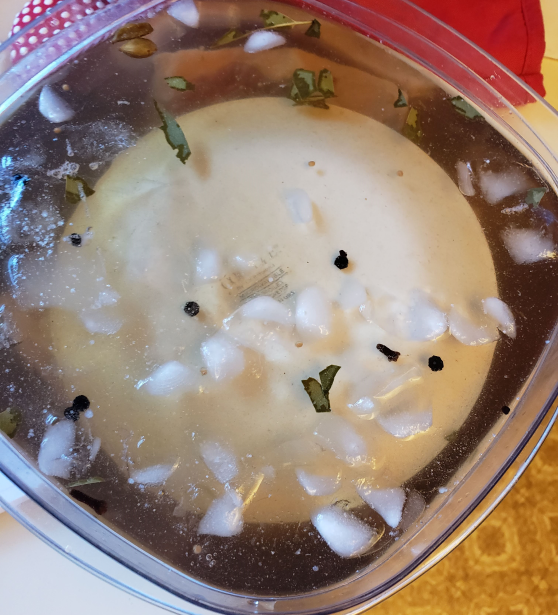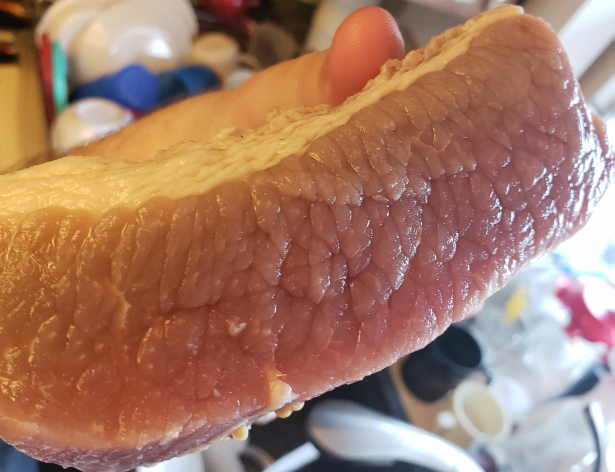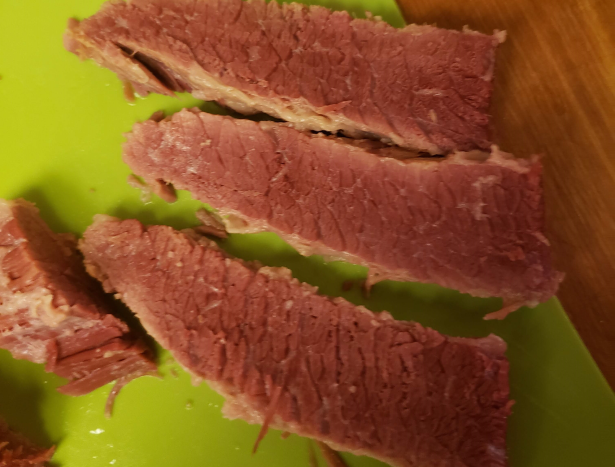KC 205 – (Probably not Poison) Corned Beef

Why hello there, and welcome to Kitchen Catastrophes, where one man tries (badly) to help you face the confusing world of food by blundering through it like a Bull through a China Shop. I’m your Porcelain Pulverizer (and man already regretting both the unintended scatological implication of that tagline, and noting said implications at the start of a post that is going to have a surprising amount of murky brown) Jon O’Guin. Today, we’re so prepared to help you get ready for St Patrick’s Day that we’ve accidentally looped back around and become unprepared. How did we achieve this task? Why is this recipe only PROBABLY not poison? Well, the brave among you will forge past such weak questions and go straight to the recipe, but I shall help the rest of you with some explanations.
Long Have We Waited in Shadow
So, the first part of the explanation is easy: Corned beef takes a long time to make. SHORT recipes for it are measured in DAYS. As such, last year, I set about making it starting on March 8th, thinking for some reason it would be done in 3 days. That was INSANELY generous, as I was working with a sort-of halfway point between 3 recipes, one from Morton’s Tender Quick (more on that in a second), as well as Bon Appetit’s Corned Beef recipe, and one from Alton Brown, and those take 5 days, 5 days and 10 days, respectively. So I whipped up the surprisingly simple and tasty skink soup last year to cover my blunder. And then I thought to myself, “Hey, let’s finish this batch, take some notes, and just write it up next year.” A forward thinking stratagem that was undermined when literally the day after I finished the recipe, I ended up in the ER for chest pains.
The most frustrating part of adulthood is the slow realization that your fear of needles is going to have to take a backseat to your fear of organ failure.
That turned out to be, as far as medical science can tell, nothing. However, this meant that it completely threw off my schedule for the week, and I did NOT take many notes. I remember where I started, and I have pictures indicating what I did, but because it’s been so long, I’m not 100% certain. Hell, I’m not 100% certain that this recipe isn’t WHY I ended up in the hospital: that’s where my joking line about this recipe probably not being poison comes from: technically, the single most unusual thing I did the day before something “popped” in my chest and I ended up in the hospital… was eat some home-cured corned beef.
And that is not an impossible thing to worry about, because there IS a danger to home-curing corned beef, which we should now take a moment to explain.
Saying Good Nite to the Bot
So, the biggest risk with home-curing meats is the danger of allowing botulism to spread in the food: improperly preserved foods can allow botulism to grow inside of it, as well as other harmful bacteria, but botulism is the big one, since it has a disturbingly high death rate at around 7.5%. So, of course, we want to take all the steps to prevent botulism from entering our food. Enter Sodium Nitrite.
(Mostly Not) Pictured Here
Sodium Nitrite is the default modern commercial compound used for curing meat, one of several that can be used to preserve meat and drive out bacteria. The issue is that there’s some concerns that nitrites might be bad for you in the long run, in high doses. The OTHER issue is that they are DEFINITELY toxic in ‘large’ doses on a CHEMICAL scale, but are relatively small doses on a culinary scale: there’s some conflicting data on this, but here’s what we know: if you took 15 grams of PURE sodium nitrite, you would be unconscious within the hour, and would be relatively lucky to survive if you were brought to a hospital within that hour. The CDC suggests no more than about 7 grams for an adult in a day, according to some sources. To put that in perspective, one teaspoon is 5 grams. Meaning that 2 teaspoons of this would likely require you get to a doctor immediately.
BUT, here’s the thing about that: while that sounds very scary, most home products are NOT pure sodium nitrite. Far from it: the most common home cure option, “pink salt” aka Prague Powder is around 6% sodium nitrite. So you would need to eat an entire half-CUP of the stuff to hit the danger zone. (and since the other 94% of the product is mostly straight-up salt, you would run into difficulties LONG before the nitrite became the issue) As long as you’re not going hog-wild, and you keep the product away from children or anyone who might accidentally use it in place of normal salt, it’s not going to cause any immediate issues. By contrast, another common option you can find, Morton’s Tender Quick, is only 0.5% sodium nitrite, and 0.5% sodium nitrate (another chemical used for the same processes), meaning it has one FIFTH the potency of the pink salt.
So that earlier picture is like, 98 point something percent NOT sodium nitrite.
And while eating a LOT of cured meats over time may be carcinogenic, keeping your personal batches to around or under a 200 ppm nitrite concentration should be perfectly safe. Bon Appetit’s recipe uses 5 teaspoons of pink salt for a 5 pound brisket in a gallon of water…and that’s actually about 20% over the guideline, which should be fine due to A: some nitrite loss in cooking, B: the assumed stance that you’re not eating this recipe every week. You could also bring it in line by just dropping 1-2 of the teaspoons.
As my multiple pictures of the Tender Quick bag should have implied to you, however, I couldn’t FIND pink salt in my area (I legitimately don’t remember how hard I tried, but I believe I checked at least 2 supermarkets, probably 3-4 over a couple weeks.) As such, while I mentioned I wasn’t 100% sure this didn’t cause my trip to the hospital, it should be noted that I AM at least 90% sure.
So, that’s all the complicated chemical warnings done. How much harder can this recipe be?
Not At All
Yeah, that’s the UPSIDE of corning beef: once you’ve got the one quasi-dangerous chemical handled, there’s really nothing to the process. You take a big chunk of beef brisket (preferably not a whole one)
I really don’t know why I chose to hold the meat at this angle. The past is a foreign country, as they say.
And then you just make a brine for it, and leave it in there for 5-10 days.
The big point of exploration/tinkering is what, exactly, you put in the brine. There are some basics: most recipes call for what are frequently referred to as “pickling spices”: mustard seed, bay leaves, cinnamon, allspice, and then a couple variables like juniper berries or dill seed, chili peppers or black peppercorns, maybe some cloves and/or ginger. Then you can add other flavors as you like. If you want, you can really play around with various combinations of solid spices: You could use cumin seed and lime juice for a tex-mex style pickle, or star anise/fennel seeds for a Five-spice pickling brine. As long as the brine has salt, sugar, and nitrite, the rest is just kind of a matter of preference, though we should note that many of the “core” pickling spices (mustard seed, cinnamon, dill, garlic) are used because they also have anti-microbial properties in addition to flavoring, so they can help minimize the risk of contamination.
And that’s where the core difficulty of my recipe comes from now: I don’t know precisely how much of what I put in the brine. All I have are a couple pictures.
And they’re not particularly CLEAR pictures, sadly.
Looking at that, I can see cloves, mustard seeds, crumbled bay leaves, what LOOK like peppercorns but I am pretty sure are not (more on that in a second), and the weird yellow scum is, I believe, granulated garlic (though it could be ground ginger), while the brown is from ground cinnamon (I think I couldn’t find our cinnamon sticks at the time). All fairly basic, the only thing I really added as my own thing was the pseudo-peppercorns, which are actually grains of paradise
Who knew paradise was so brown?
I briefly covered them in my April post hyping up the (now infamous) last season of Game of Thrones, but Grains of Paradise are basically if black peppercorns had a kid with ginger, cardamom, and cinnamon. I used them in this recipe to cover…basically all of those flavors, as well as allspice. Unless that brown powder was allspice, and I used these to cover the cinnamon…The point is that I covered most of the bases SOMEHOW.
I brought these spices to a boil with the tender-quick, which covers the salt, sugar, and nitrite, and then poured it into a container with some ice (you don’t want the liquid to be hot when you add the corned beef, as then it would start cooking it, and that would screw up the brining), and added my chunk of meat, and then a plate to keep the meat submerged.
I want to make a “More Weight” joke here, but my pedantry won’t let me, since obviously the beef would just sound like “mbulgglug wugougofd”, since it’s under liquid.
And that’s it. As I noted earlier, you can turn the meat over once a day to ensure that it’s all curing at the same rate. After a week in the brine, this is how the brisket chunk looked:
Kinda looks like grapefruit.
That wasn’t quite where I wanted it to be, so I decided to leave it in for another couple days. Partly because I felt it could go longer, and partly because that day I had a play, and I didn’t want to try and cook a brisket for 4 hours in the afternoon before going to a show. I finally pulled it on the 9th day of brining. If I HAD to explain why…well, the answer would be “Because that was when St Paddy’s Day was”. And let me tell you, when I pulled the brisket from the brine, and rinsed it off, I was a little worried.
Oh dear, the grapefruit’s gone bad.
That is some VERY grey looking meat, for a dish that’s supposed to put out very RED looking meat. However, a quick check of some curing forums told me this wasn’t uncommon, and that the red color becomes more prominent as the meat cooks. So I decided to press on. I went with Alton’s approach here: Bon Appetit cooks the corned beef by boiling it with another small batch of the spice mix for the brine, and then boils it for hours, adding some vegetables in the last 40 minutes. Alton, by contrast, doesn’t reintroduce spices, but does cook the vegetables (some carrots, celery, and onions) with the beef for the full 3 hours. (Quick fun fact: celery is actually one of the core natural sources of sodium nitrate, with those wishing to avoid using the more dangerous chemicals using celery juice or powder as the substitute) So I threw the meat in with the veg, and cooked it away. And you know what? The results were pretty damn good!
A little blurry, but otherwise great.
That LOOKS like corned beef. And it TASTES like corned beef. It was a LITTLE firmer than I’d like it to be, but otherwise, it was almost entirely on point. Tragically, no one other than me had much of it, because it wasn’t done cooking until around 9 PM (I had a show that afternoon, so I didn’t get home to start the cooking process until 5, so it wasn’t done until right around 9.) At which point I ate some of it, sliced it up, popped it in our family’s smaller fridge, and ended up in the hospital. And then, since I was the only one who knew it was even IN the fridge, only I was eating any of it until the next weekend, at which point both my mom and Nate said it had been in the fridge too long, and they didn’t trust it. So you really only have my word that this turned out fine. Make of that what you will.
But yeah, if you pick up some meat this Friday/Saturday, you have JUST enough time to brine it for 10 days for the holiday this year! THAT’S the advantage of pre-planning! Was it worth not knowing what the recipe was, exactly? Nobody’s perfect.
THURSDAY: THERE’S A COUPLE OPTIONS, WE’LL SEE WHICH ONE MAKES IT.
MONDAY: HAVING SHOWN YOU ONE MAIN COURSE, JON UNPACKS SOME SIDES FOR PADDY’S DAY.
Recipe
Corned Beef
Serves 6-8
Ingredients
Brine
6 cups water
1 cup salt
¼ cup brown sugar
2 teaspoons pink curing salt
(alternatively, replace salt, sugar, and curing salt with 1 cup Morton’s Tender Quick)
½ tsp tsp garlic powder
6 whole cloves
1 teaspoon mustard seeds
20 grains of paradise (split into 8 black peppercorns, 6 allspice berries, and 1 stick cinnamon if unavailable)
2 bay leaves, crumbled
½ tsp ground cinnamon
1 trimmed beef brisket (5 pounds)
1 quart ice
Finished meal
1 large onion, quartered
2 large carrots, chopped into large chunks
4 ribs celery, chopped into large chunks
Water
Preparation
To make the brine, add all ingredients except brisket and quart of ice to a boil in a pot. While pot heats, find a sufficiently large container, to hold brine, beef, and ice, and add the ice. Let the brine boil for 5-10 minutes, then pour over the ice. (if your chosen container is glass, this is more safely done by adding the ice to the heated brine, and pouring both into the container) once cooled, add the beef brisket, and submerge using a meat weight or plate. Place in a refrigerator and let brine for up to 10 days, turning once per day.
Once fully brined, remove the meat from the container, and rinse. Place in a large pot with vegetables, add water to cover by 1 inch, and bring to a boil. Let boil for 10 minutes, then reduce heat to medium and cook for another 3.5-4 hours. Remove the beef, and slice for service.















